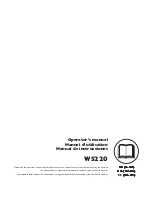
OPERATING
English
–
11
Basic working techniques
The movement of the wall saw is controlled by the remote
control.
•
The blade’s rotational direction may be selected by
the operator, which means that the water spray may
be directed as desired regardless of which way the
saw is turned on the rail. Make sure to use the right
amount of cooler water for the system and the blade.
The cooler water for the blade cools the segments and
binds the dust generated through sawing. The water
flow may be adjusted using the water regulation
spigot.
•
Always begin by cutting a guide cut to a depth of 2-4
cm (0,8"-1,6"). This should be cut with a lower feed
speed than the maximum possible in order to
guarantee a straight cut.
•
Subsequent cuts may be made deeper, approximately
4-7 cm (1,6"-2,8"). The depth must be decided on from
case to case depending on factors such as the
hardness of the concrete, the amount and placement
of reinforcement, etc.
•
When making these cuts, the longitudinal feed speed
should be set to maximum for optimal sawing
performance. The feed speed will automatically be
regulated by a processor that continually adjusts the
speed in order to retain optimal sawing effect.
•
If the machine is run on single phase operation, the
available output is reduced and the cutting depth must
be reduced compared to three phase operation. A rule
of thumb might be to reduce the cutting depth by half.
•
It may often be more time efficient to make shallower
cuts in several runs than to attempt a deeper cut.
Shallow cuts create less cutting surface and thus put
higher pressure on the blade segments, which helps
to keep the blade sharp. When cutting rebar
lengthwise, it is important to cut the rebar according to
the illustration in order to keep the blade sharp. In all
other respects the cut should be as shallow as
possible. It is also possible to begin cutting from the
other end of the cut since it is not certain that the rebar
follows the cut the whole way.
•
In cases where the wall is thinner than the maximum
depth of the blade, it is advantageous to feed the
blade as deep as possible once it has passed through
the wall. In this way, the cutting surface is reduced and
pressure on the blade’s segments is increased. It is
also advantageous to work this way in cases when
over cutting is not allowed, since the 'wedge'
remaining after sewing becomes smaller.
a = Over cut distance
b = Cutting surface
•
The blade guard should always be mounted on the
saw when in operation. If the blade guard catches the
ceiling, for example during over cutting of a doorway,
one of the blade guard’s gables may be temporarily
disassembled.
Summary of Contents for WS220
Page 25: ...English 25 TECHNICAL DATA Dimensions ...
Page 53: ...French 53 CARACTÉRISTIQUES TECHNIQUES Dimensions ...
Page 80: ...80 Spanish DATOS TECNICOS Dimensiones ...
Page 82: ......
Page 83: ......












































